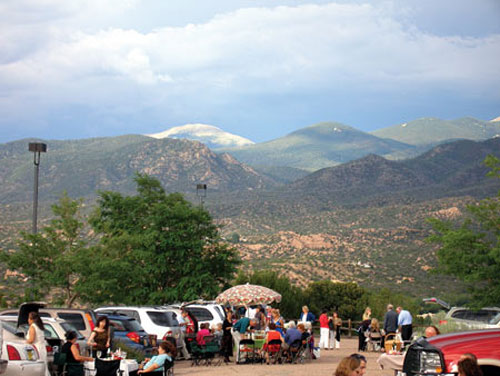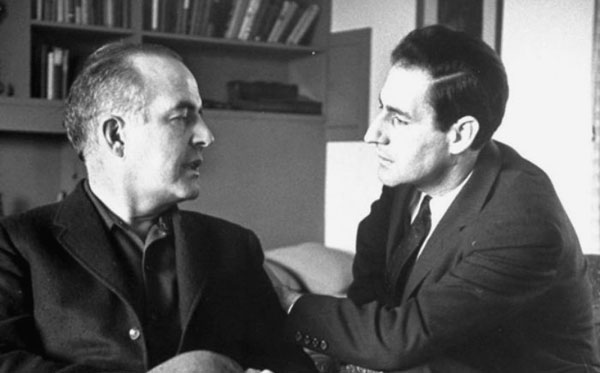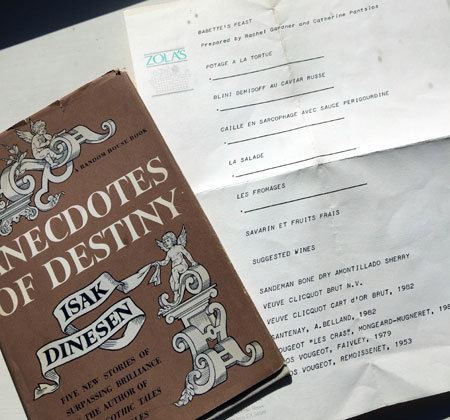|
Thinking back, as January invites us to do, my mind leaps to Santa Fe Opera as the high point of the year. Not just because I discovered and fell in
love with an opera, but because the pleasure of culture was joined by another pleasure to create a memorable feast. To paraphrase Gertrude Stein: “Opera and food, food and
opera, both excellent things.”
When you take in 6 operas in 8 days, do you need to eat? The cultural high of such an “orgy” doesn’t need much more than nibbles.
On every patio at Santa Fe Opera we (my life companion Kim and I) found champagne, coffee, nuts and sweets, and in addition, at a newly opened area with café tables we could get a
decent vegie wrap or a tenderly, one could almost say, artistically assembled box of cheeses, crackers and fruit. At the periphery, a higher-end restaurant served dinners plus
pre-performance lectures, but most popular was the vast parking area where tailgate picnics offered all-round views of the mesa and its dramatic sunsets. The summer festival, now
in its 60th year, is famous for its top quality productions (often outplaying the Met and SF Opera) and for its summer storms. With its bold architecture and open stage, lightning
and thunderclaps were “side dishes” to the feast.
 |
The “main dish” was an almost unknown opera, Vanessa, by the American composer Samuel Barber—an opera that starts with a
menu. Yes, a menu. French cuisine. Three women closeted on a rich estate somewhere in Scandinavia are planning a dinner for a
passionately awaited guest, a man who will turn out not to be the man they expected.
This is how the opera opens:
Erika: “Potage crème aux perles.”
Major-Domo: “Potage crème aux perles.”
Erika: “Ecrevisses à la bordelaise.”
Major-Domo: “Ecrevisses à la bordelaise.”
Vanessa: “Find something better than that!”
Erika: “Alors… langoustines grillées sauce aux huitres.”
Major-Domo: “Langoustines grillées sauce aux huitres.”
Erika: “Faisan braisé au porto.”
Vanessa: “Sick of pheasant… Canard!”
Erika: “Canard farci sauce Savoie.”
Vanessa: “Too many sauces.” (etc.)
After the dessert—Gateau d’amande au miel—the wine is
selected: one bottle of Montrachet and two bottles of
Romanée-Conti.
Wouldn’t you have liked to be the visitor expected that night?
Vanessa (Erika, Virginie Verrez)
Artistic and Culinary Recognition
Vanessa’s libretto was written by Barber’s partner, composer and librettist Gian Carlo Menotti. (You can read my review here.) Vanessa is a poetic masterpiece about the mysteries of love
delusions. Each one of the three women, the old Baroness, middle-aged Vanessa and her young niece Erika, has a different
illusion about the visitor who comes to change their destiny one night. At the opening at the Met, in 1958, the psychological
suspense of the story seemed to make the opera a success. (The performance with top singers was recorded on CD.) But almost
over night, Barber’s luck turned with a Salzburg Festival flop that led to the rejection of the work by the opera world. The
composer’s romantic, passionate music did not fit the atonal, dissonant fashion of the day. So it took a good half century to unearth Vanessa for a new star turn. The brilliant Santa Fe
production by director James Robinson excited everyone. Looking into my crystal ball for 2017, Vanessa will soon come to an opera stage near you.
 |
Samuel Barber and Gian Carlo Menotti
Kim and I had never heard of Vanessa, and now we learned that the work was inspired by Isak Dinesen’s Seven Gothic Tales. We
both used to have a passion for Dinesen—pen name for the great Danish storyteller Karen Blixen (Out of Africa). Dinesen was “a
dear friend” of the two men, which gave us a keen appetite to look back into these sources of inspiration. Where might a dinner menu sung in three voices come from?
Not too surprisingly, we quickly arrived at “Babette’s Feast,” a story from Dinesen’s Anecdotes of Destiny. You may remember
the movie version that won an Academy Award in 1988. The minute we came home from Santa Fe we revisited the film on
Netflix. Once again we were in the grip of the tragic-comic tale about a great woman chef, a political refugee from the Paris
barricades, who serves a $10,000 dinner to two spinster sisters and their pious little sect in a Danish village. The entire flock is
dead scared by the goings on in Babette’s kitchen, where a giant turtle, a whole crate of quails, the finest wines and exotic fruits
are carted in from abroad. When the meal is served, the puritanical flock is unable and unwilling to taste anything good, not to mention artistic, in Babette’s cooking.
There is, however, one connoisseur at the table. One guest, an old General, recognizes what he is eating and drinking, and
reminisces about a certain chef at the Café Anglais, “a person known all over Paris as the greatest culinary genius of the age,
and—most surprisingly—a woman!”
Karen Blixen (Isak Dinesen)
Babette never learns that there was one person who fully appreciates her art. She doesn’t hear any comment about her
meal. She is not aware (unless she knows perfectly well) that her food and wine have spiritually transformed everyone at the table
. “Of what happened later in the evening,” Dinesen writes, “nothing definite can here be stated. None of the guests later on
had any clear remembrance of it. They only knew that the rooms had been filled with a heavenly light, as if a number of small
halos had blended into one glorious radiance.”
Babette’s story suddenly held a parallel to Samuel Barber’s unappreciated opera that now was the toast of the season.
Babette (Stéphane Audran)
Afterwards, the sisters hear that Babette has spent all her money, a lottery fortune, on her dinner. They ask her, “’So you will be
poor now all your life, Babette?’ ‘Poor?’ said Babette. She smiled as if to herself. ‘No, I shall never be poor. I told you that I am a
great artist. A great artist, Mesdames, is never poor.’”
Life Imitating Art
When I opened Kim’s first edition of “Anecdotes of Destiny” to
savor the story again, out fell a folded sheet of fine, thick, ivory-colored paper. It was a menu, with the letterhead of Zola’s, the
SF restaurant that used to be on Sacramento Street. It read, “Babette’s Feast, prepared by Rachel Gardner and Catherine
Pantsios.” With wonder, we went over the menu again and remembered. Babette’s night at Zola’s was part of the nation
-wide event created in 1988 by some 500 restaurants to celebrate the opening of the film that had just won an Academy
Award. (Among them were the Petrossian in New York, Le Pavillon in Washington, Four Oaks in Los Angeles, the Ritz
Carlton in Laguna Niguel, Calif., La Truffe in Philadelphia, and Cafe Chauveron in Miami.)
Here is the menu, exactly as served in the story and the film:
Potage à la tortue
Blini Demidoff au caviar Russe
Caille en Sarcophage avec sauce Perigourdienne
La Salade
Les Fromages
Savarin et fruits frais
A longish list of wines and champagne followed, crowned by a Veuve Cliquot 1982 and a Clos Vougeot, Remoissenet, 1953
(standing in for the original Clos Vougeot Louis Latour of the story). (A view of Caille en Sarcophage.) If my memory doesn’t
fail me, taking part in the dinner cost about $80 per person, while the filmmakers spent $8,000 to put the feast on the table for the movie.
We attended “Babette’s Feast” with two gourmet friends and were convinced it was a great event, life having for once imitated
art. All four of us were feeling high, inspired, happy. Kim remarked that she had never had an elaborate dinner that
caused her so little anxiety about the calories consumed. This gave us pause. Calories? Not one of us felt the stuffed-belly, tight
-belt sensation we knew only too well from eating too well. How come? Was it the delicate size of the portions? Or did the sophisticated details of the meal hide a secret?
 |
Kim said, “Now we know for sure that Karen Blixen was an anorexic. Remember that she spent the last years of her life on
oysters and champagne and nothing else? Babette’s feast is an anorexic fantasy -- that’s the hidden secret.” All of a sudden, we
felt another surprising sensation: could it have been the slightest suspicion of hunger? We all confessed: we didn’t feel like we had
eaten much of anything. Was this really possible, or were we making up a story?
One thing was clear: the cultural best of 2016 gave us everything we wished for, opera, literature, cinema, all served together with
a silver spoon, leaving us slightly, deliciously hungry for more.
You can find out about Babette’s ingredients: Simply go back to 1988 and the NYTimes:
http://www.nytimes.com/1988/03/02/garden/in-babette-a
-great-feast-for-the-palate-and-the-eye.html?
Babette’s Feast trailer: http://www.curzonartificialeye.com/babettes-feast/
|